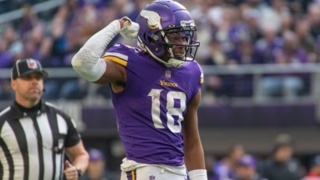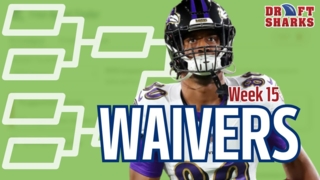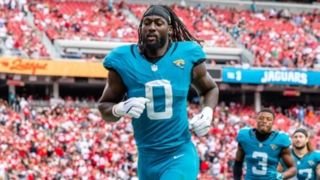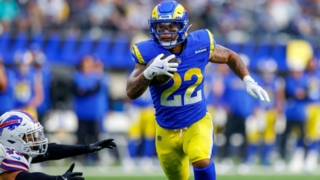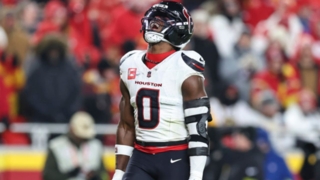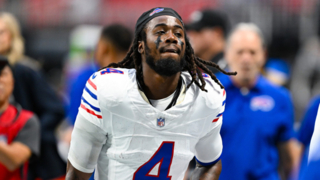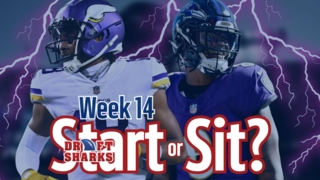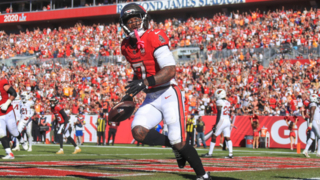2018 RB Strength of Schedule

Need another reason to back away from Lions RBs? Well, stick around to the end of this article and you’ll get one. (Or you could cheat and skip over the juicy middle … but why would you do that?)
Last week, I broke down recent historical fantasy points allowed stats for QB defenses and projected a 2018 strength of schedule for fantasy passers. Now we turn to the guys lining up behind them, the RBs that have gone back to dominating the top of fantasy football draft boards.
Just like last time, let’s start in the past …
Effects on RB Scoring
I looked back over RB points (PPR) allowed every season since 2002, when the league expanded to 32 teams. Just like at QB, we saw the impact gaps grow at the top and bottom of the rankings.
The 1st column in the table below indicates the average difference between the defense in that ranking spot and the median points allowed to fantasy RBs over the same span (2002-2017). The 2nd column shows the gap between each consecutive pair of ranking spots (in percentage points; not true percentages).

As you can see, gaps of generally less than 1.5 percentage points through the middle give way to larger splits at the top and bottom of the rankings. This proved true annually, too. The tougher the RB defense, the more drastic the impact on RB scoring. On the flipside, the easier your matchup, the more drastic your backfield scoring boost.
On average, we also found the top 9 and bottom 9 RB defenses affecting opponent scoring by 10+% vs. the league median. So I used those ranges to gauge potential impact when compiling the 2018 strength-of-schedule rankings I’ll get to in a few minutes.
What Makes a Tough RB Defense?
Before projecting the good and bad defenses for 2018, I wanted to find out what tends to impact points allowed the most. Even in this era of increased passing, you probably won’t be surprised to learn that rushing yards and rushing TDs drive these rankings.

The chart above displays the correlation between the 6 primary RB stat categories and fantasy points allowed, by year. As you can see, each color represents a different stat. And we’re looking for correlations closest to 1.0.
From 2000 through last season, rushing TDs and rushing yards each sport a median correlation of 0.774. No other stat tested beat 0.614.
Obviously, all of these categories contribute to RB fantasy scoring, but we’re looking for what we can expect to have the most impact so we know where to look when we project. Yards and TDs are the places to look.
The problem with TDs, of course, is that they’re difficult to predict. Over the same span, TDs consistently fall short of a 0.6 correlation with rushing yardage -- at times short of 0.5. What’s that mean? Just because a defense gives up a lot of yards on the ground does not necessarily mean that it also ranks among the most susceptible to rushing TDs. Same deal with the correlation between rushing attempts and TDs. So, just because a defense faces more carries than most of the league, we can’t necessarily assume that D will allow more of those to reach the end zone.
Rushing yards and rushing attempts, on the other hand, have shown a perennial correlation of 0.75 or better in recent seasons.
That makes sense. We would assume that those defenses facing more rushing attempts would allow more rushing yards. And we’d be right.
Looking Ahead
So now let’s get to what really matters: How this will impact our 2018 fantasy teams. Time to project the top 9 and bottom 9 RB defenses, starting with the most attractive fantasy matchups.
Over the past 5 years, an average of 3.75 bottom-9 RB defenses have stayed down in that range the following season. Over the same span, 6 of each year’s bottom 9 could be found among the previous season’s bottom 16. With that in mind, here are our bottom 9 for 2018, starting with the 4 likely to repeat:
Who Will Remain Weak?
Buffalo Bills
Last year’s friendliest RB defense allowed the league’s 4th-most rushing yards each of the past 2 years and finished bottom 9 in PPR points allowed to RBs each time. The Bills added Star Lotulelei in free agency, but he rated poorly against the run last year (per Pro Football Focus). An offense that promises to be terrible also should help drive up opponent rushing volume … because this team’s gonna spend a lot of time trailing.
Cincinnati Bengals
Generally a solid-to-good unit overall, Cincinnati has finished 3 of the past 4 years among the league’s 12 friendliest RB defenses. That included last season’s 3rd-worst ranking, the 2nd bottom-4 performance among the past 4 years. We’ll see if a switch to Teryl Austin at DC changes anything, but his Lions defenses ranked 19th, 18th and 18th in rushing yards allowed the past 3 years.
San Francisco 49ers
The Niners have added intriguing pieces to their defense in recent drafts, but they still checked in 8th-worst in RB points allowed in 2017 after consecutive dead-last finishes. Perhaps they’ll continue trending upward and jump out of this range, but we wouldn’t bet on them leaping all the way to negative-matchup territory.
Washington
Like the Niners, this crew has added front-7 pieces capable of turning the performance around in 2018. But D-linemen Jonathan Allen and Da'Ron Payne need to prove they can turn around a run defense that finished each of the past 3 years among the bottom 9 in rushing yards allowed. Last season found Washington 32nd in that category. And this D ranked 7th-friendliest to RB PPR scoring in 2016 and 2017.
Who Will Join Them?
Atlanta Falcons
Last year marked the 1st time in 5 seasons that the Falcons broke out of the bottom-10 RB defenses. But then they let NT Dontari Poe and DE Adrian Clayborn leave in free agency. In their places, Atlanta will rely on 2017 first-round DE Takk McKinley, along with 3rd-round rookie DT Deadrin Senat and free-agent DT Terrell McClain. Perhaps the changes work and the defense continues trending upward. But at the moment, the Falcons look like as good a bet to fall as any neutral-range RB defense.
Indianapolis Colts
Over the past 10 years, the Colts have finished 1 season outside of “bad” (for them) range as a RB scoring D. Now comes a 1st-time DC with a change to the base alignment and a young crew of LBs with lots to prove. We’ll see if Andrew Luck can get the offense back to at least applying some scoring pressure.
Kansas City Chiefs
This might be the surprise pick of the group. The Chiefs allowed the 7th-fewest RB PPR points in the league last year, their 3rd top-9 finish among the past 4 years. And they finished 15th the other season in that range. But there’s been at least some luck involved. The Chiefs have also finished 3 of the past 4 seasons among the league’s bottom 8 in rushing yards allowed. Last season, Football Outsiders rated them dead last in opponent-adjusted run-D efficiency. Even if luck doesn’t fully turn against the Chiefs in 2018, they don’t look like a group you’ll need to avoid.
Los Angeles Chargers
I love what the Chargers are building on defense -- and their roster as a whole -- but the unit allowed the league’s 2nd-most rushing yards last season. That marked its 3rd finish among the bottom 7 over the past 4 years. Joey Bosa and Melvin Ingram are stellar all-around DEs who lead a scary pass rush, but the LB corps has plenty to prove -- and run D just isn’t nearly as important to NFL teams as it once was.
New York Giants
New Giants DC James Bettcher came from an Arizona defense that perennially ranks among the league’s toughest vs. the run. But Bettcher inherits a Giants crew that finished 3 of the past 4 seasons among the NFL’s bottom 4 in total yards allowed and bottom 9 in rushing. Those Giants also finished 4 of the past 5 years among the 11 friendliest RB defenses. HC Pat Shurmur obviously tapped Bettcher to improve such things, but we’ll need to see it from a group getting used to his change in scheme (including the shift to a 3-4 base). Gone is DE Jason Pierre-Paul, a terrific all-around defender. In is LB Alec Ogletree, who Pro Football Focus graded 75th among 86 qualifying off-ball LBs last year -- and even worse against the run.
5 Who Will Stay Tough
On the other side, we’ve seen an average of 4.75 “top 9” defenses repeat as tough RB matchups in fantasy the following year. Over the same span, 6.5 of each year’s top 9 ranked among the previous season’s top 16. Here are 5 we expect to remain tough:
Arizona Cardinals
As I mentioned with Bettcher, the Cardinals are tough against the run every year. They have finished 5 straight seasons among the top 9 in RB points allowed and 7 straight among the top 12. Losing Bettcher adds a challenge, but new HC Steve Wilks comes from a similarly tough-to-run-on Carolina defense.
Carolina Panthers
On that note, the Panthers ranked 3rd, 6th and 4th in rushing yards allowed over the past 3 seasons. They watched DT Star Lotulelei leave for a big free-agent contract in Buffalo, but replacing him with Dontari Poe might actually help the run D. Pro Football Focus issued Lotulelei a 48.3 grade in run D last year, compared with a 78.7 for Poe. A 2nd straight year of change at DC adds some risk, but Carolina promoted Eric Washington to the post after he ran the D-line for 7 years. Let’s go ahead and assume he knows about run defense.
Houston Texans
Even with J.J. Watt struggling through injuries over the past couple of seasons, Houston has finished 4 straight campaigns among the league’s top 13 in limiting opponent rushing yards and RB fantasy points. A healthy Watt can only help that pursuit in 2018.
Minnesota Vikings
Mike Zimmer’s crew has finished 3 straight years among the 7 toughest RB defenses. Then the Vikings added DT Sheldon Richardson. Plus, they just might improve on offense with new QB Kirk Cousins and repaired RB Dalvin Cook. That could find them ahead more often and motivate opponents to throw more. Bottom line: Don’t get excited if your RB is facing Minnesota.
Philadelphia Eagles
Philly brings a shorter record of production in this area than the other repeat teams. But Football Outsiders has rated the Eagles top-5 in overall defensive efficiency each of the past 2 years, top-13 against the run each time. The line should only get better with the development of 2nd-year DE Derek Barnett plus additions of Michael Bennett and DT Haloti Ngata.
4 Who Will Join
Baltimore Ravens
This pick feels like cheating. Last year marked the Ravens’ 1st time outside the top 9 RB defenses since 2012. It also marked their 1st time outside the top half since the 2000s began. Over that 18-year span, Baltimore has finished only 3 seasons outside the top 9. We’ll go ahead and stick with history over an apparent 2017 outlier here.
Green Bay Packers
The Packers sported the league’s 9th-friendliest RB defense last year but ranked just middle of the league in rushing yards allowed. Better: Football Outsiders rated them 8th in opponent adjusted rush-D efficiency. The Pack also rated as a top-half run defense the 3 years prior. Now, Green Bay has a new DC (Mike Pettine), who piloted 3 of his 4 Jets defenses to top-7 rankings in yards allowed per carry. The Packers also imported former Jets DE Muhammad Wilkerson. Even in a down 2018, Wilkerson still checked in among the top-third of interior linemen in PFF’s run-D grading.
New England Patriots
The Patriots finished in neutral territory vs. RB scoring last year, but that marked their 4th straight ranking among the top half of RB defenses. The defense hasn’t provided more than a 2-percentage-point boost to RB scoring in any season since 2010. New England moved to improve against the run in the offseason, acquiring NT Danny Shelton. He ranked 19th among all interior linemen in PFF’s run-D grading last year.
Pittsburgh Steelers
Another neutral fantasy-RB defense last year, Pittsburgh ranked 10th-best in rushing yards allowed. Even as the 8th-friendliest RB defense the year before, the Steelers ranked 13th in yards allowed. That makes 4 straight years among the league’s top half in that category. A maturing set of OLBs could help an already-strong D-line.
2018 RB Schedules
After setting out the top 9 and bottom 9, I applied those selections to every team’s schedule to see who might get helped or hurt the most.
The 1st 4 columns in this table explain themselves. The 16-game factor represents the full-season impact. Each week starts as a 1 (or 100% of average scoring). Every “good” matchup carries a value of 1.186, because the bottom-9 RB defenses have added an average of 18.6% to RB scoring over the reviewed span.
On the other hand, a “bad” matchup carries a value of 0.831. On average over the same span, the top-9 RB defenses took away 16.9% of RB points.

Of course, most fantasy seasons end in Week 16, so here’s the same exercise with Week 17 removed:

See why I singled out the Lions up top? Detroit gets just 1 “good” RB matchup all year … at least before the regular season shatters all of our expectations. Blame 2 matchups apiece with Minnesota and Green Bay, plus 2nd-half clashes with Carolina and Arizona. We’ll see if a Week 3 home date with the Patriots proves bothersome.
The Raiders, however, get a much nicer draw -- thanks largely to my classifications of the division-rival Chargers and Chiefs as positive scoring matchups.
We’ll see how it all plays out. In the meantime, use this as another tie-breaker (NOT a plan-driver) in your drafts.
Draft using the best dynamic tool in the industry. Our fantasy player valuations (3D Values) change during your draft in response to...
- Exact league settings - direct sync
- Opponent and Team Needs
- Positional scarcity & available players
- Ceiling, injury risk, ADP, and more!
You need a dynamic cheat sheet that easily live-syncs with your draft board and adapts throughout your draft using 17 crucial indicators.
Get your Draft War Room Today
 Redraft
Redraft Dynasty
Dynasty Best Ball
Best Ball
